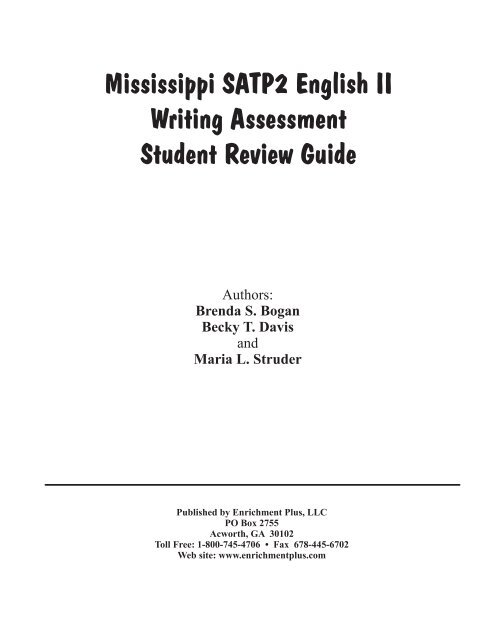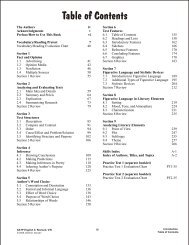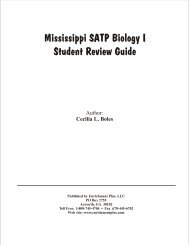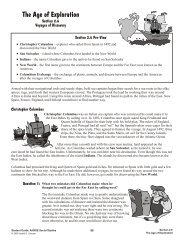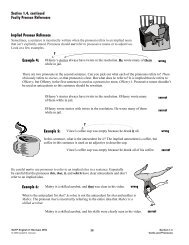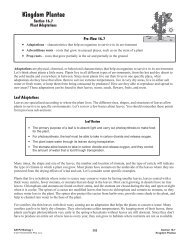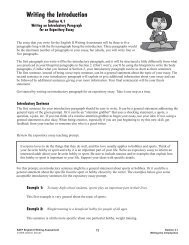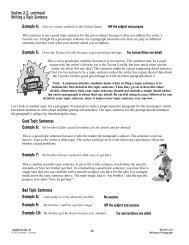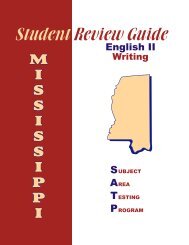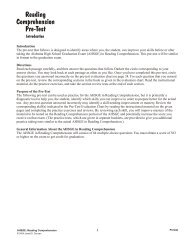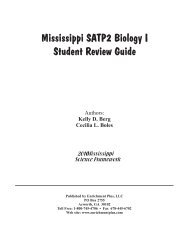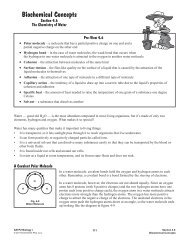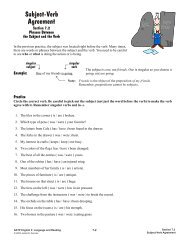Mississippi SATP2 English II Writing Assessment ... - Enrichment Plus
Mississippi SATP2 English II Writing Assessment ... - Enrichment Plus
Mississippi SATP2 English II Writing Assessment ... - Enrichment Plus
You also want an ePaper? Increase the reach of your titles
YUMPU automatically turns print PDFs into web optimized ePapers that Google loves.
<strong>Mississippi</strong> <strong>SATP2</strong> <strong>English</strong> <strong>II</strong><br />
<strong>Writing</strong> <strong>Assessment</strong><br />
Student Review Guide<br />
Authors:<br />
Brenda S. Bogan<br />
Becky T. Davis<br />
and<br />
Maria L. Struder<br />
Published by <strong>Enrichment</strong> <strong>Plus</strong>, LLC<br />
PO Box 2755<br />
Acworth, GA 30102<br />
Toll Free: 1-800-745-4706 • Fax 678-445-6702<br />
Web site: www.enrichmentplus.com
Table of Contents<br />
The Authors/Acknowledgments iv Section 7<br />
Preface/How to Use This Book v Using Complete Sentences and Correct Mechanics<br />
Essay <strong>Writing</strong> Steps and Tips vi 7.1 Proofreading for Complete Sentences 125<br />
7.2 Proofreading for Commonly Confused<br />
Section 1 Words and Spelling 129<br />
Understanding the Prompt 7.3 Proofreading for Capitalization 135<br />
1.1 Choosing a Prompt 7 7.4 Proofreading for Punctuation 138<br />
1.2 Understanding the Informative <strong>Writing</strong> Mode 10 7.5 Proofreading Review 143<br />
1.3 <strong>Writing</strong> on the Topic 18<br />
1.4 Understanding Purpose, Audience, and Section 8<br />
Appropriate Language 25 Using Verbs, Pronouns, Adjectives, and Adverbs<br />
8.1 Proofreading for Correct Tense and<br />
Section 2 Irregular Verb Usage 145<br />
<strong>Writing</strong> a Paragraph 8.2 Proofreading for Subject-Verb Agreement 151<br />
2.1 Using “Basic Ingredients” for a Paragraph 29 8.3 Proofreading for Correct Pronoun Usage 158<br />
2.2 <strong>Writing</strong> a Topic Sentence 31 8.4 Proofreading for Correct Adjective<br />
2.3 <strong>Writing</strong> Supporting Sentences and Details 36 and Adverb Usage 167<br />
2.4 Staying On-Topic 41 8.5 Proofreading Review 173<br />
2.5 <strong>Writing</strong> a Conclusion Sentence 44<br />
2.6 Finalizing a Paragraph 49 Section 9<br />
2.7 Reviewing Point of View 55 Understanding and Punctuating<br />
Clauses and Phrases<br />
Section 3 9.1 Understanding and Punctuating<br />
Planning the Essay Simple and Compound Sentences 175<br />
3.1 Introducing the Parts of an Essay 57 9.2 Understanding and Punctuating<br />
3.2 Brainstorming for an Expository Essay 58 Complex Sentences 178<br />
3.3 Brainstorming for a Position Paper 65 9.3 Proofreading for Dangling Participles,<br />
3.4 Brainstorming for a Response to Literature 68 Misplaced Modifiers, and<br />
Parallelism and Punctuating<br />
Section 4 Participles 182<br />
<strong>Writing</strong> the Introduction 9.4 Using and Punctuating Direct<br />
4.1 <strong>Writing</strong> an Introductory Paragraph for and Indirect Quotes 190<br />
an Expository Essay 73 9.5 Proofreading Review 195<br />
4.2 <strong>Writing</strong> an Introductory Paragraph for<br />
a Position Paper 80 Section 10<br />
4.3 <strong>Writing</strong> an Introductory Paragraph for <strong>Writing</strong> Effective Sentences and Paragraphs<br />
a Response to Literature 84 10.1 Choosing Effective Words 197<br />
10.2 Using a Variety of Sentences 202<br />
Section 5 10.3 Adding Transitions 207<br />
<strong>Writing</strong> the Body and the Conclusion 10.4 Rewriting Your Final Essays 213<br />
5.1 <strong>Writing</strong> the Body Paragraphs for an<br />
Expository Essay 87 Appendix<br />
5.2 <strong>Writing</strong> the Body Paragraphs for a Additional <strong>Writing</strong> Prompts<br />
Position Paper 97 Expository Essay Prompts A-1<br />
5.3 <strong>Writing</strong> the Body Paragraphs for a Position Paper Prompts A-2<br />
Response to Literature 104 Response to Literature Prompts A-3<br />
5.4 <strong>Writing</strong> the Conclusion Paragraph 109<br />
Section 6<br />
Introducing Proofreading<br />
6.1 Using the Writer’s Checklist 117<br />
6.2 Proofreading the Expository Essay 119<br />
6.3 Proofreading the Position Paper 121<br />
6.4 Proofreading the Response to Literature 123<br />
<strong>SATP2</strong> <strong>English</strong> <strong>II</strong> <strong>Writing</strong> <strong>Assessment</strong><br />
© 2012 <strong>Enrichment</strong> <strong>Plus</strong>, LLC<br />
iii<br />
Introduction<br />
Table of Contents
Preface<br />
The <strong>Mississippi</strong> <strong>SATP2</strong> <strong>English</strong> <strong>II</strong> <strong>Writing</strong> <strong>Assessment</strong> Student Review Guide is written to help students review and<br />
practice the writing skills needed to receive a passing score on the <strong>English</strong> <strong>II</strong> <strong>Writing</strong> <strong>Assessment</strong> essay. This writing<br />
guide is based on the <strong>Mississippi</strong> <strong>Writing</strong> <strong>Assessment</strong> Program for <strong>English</strong> <strong>II</strong> and the 2006 <strong>Mississippi</strong> Language Arts<br />
Framework - Revised both published by the <strong>Mississippi</strong> Department of Education.<br />
How To Use This Book<br />
Students:<br />
The <strong>English</strong> <strong>II</strong> end-of-course test is required for graduation. You must pass a multiple-choice exam that tests<br />
vocabulary, reading, grammar, and writing, and you must pass a writing test. This book is a review for the <strong>English</strong> <strong>II</strong><br />
<strong>Writing</strong> <strong>Assessment</strong> essay.<br />
jRead each section of this book sequentially and do the exercises. Each section builds on the one before it. You<br />
will be given step-by-step instruction on how to construct essays so that you will receive a passing score. If you<br />
follow, practice, and become proficient in using the steps in this book, you will do better than just pass with a<br />
minimum score of two. You should score at least a three if not a four.<br />
kRemember that writing a good essay is a process of planning, writing, proofreading, and re-writing. Make sure<br />
you go through the steps of proofreading your essays. In the proofreading sections of this book, you will be<br />
given opportunities to proofread other essays. If you cannot identify and correct the mistakes in these essays,<br />
review and practice the grammar and usage skills taught in that section.<br />
lWhen proofreading your essays, refer to the checklist on page 117. Make sure you meet the requirements for<br />
each of these items.<br />
mAfter writing, proofreading, and rewriting your essays, choose other prompts given in the Appendix A of this<br />
book. Practice the same steps with new prompts. Keep practicing until you can write essays that meet all the<br />
checklist requirements.<br />
Teachers:<br />
This review guide is also intended to save you time in the classroom. It can be used for classroom instruction or for<br />
individual student review. This student guide gives specific step-by-step instruction on how to write essays that will<br />
pass the <strong>English</strong> <strong>II</strong> <strong>Writing</strong> <strong>Assessment</strong>.<br />
jWhen teaching or tutoring individual students, use the strategy outlined above for students. Students can go<br />
through this book to learn how to write essays in a step-by-step manner. You can provide additional guidance<br />
and correction. The Student Essay Booklet that accompanies this guide gives space for students to practice each<br />
step of the writing, proofreading, and rewriting process. As the student practices each step, you should see<br />
improvement from one step to the next.<br />
kFor classroom study, we recommend you purchase a class set of guides for use in the classroom or assign guides<br />
to students for out-of-classroom work. Since these guides are step-by-step instruction, you can teach and give<br />
practice directly from the text. Have students use the Student Essay Booklet to keep up with their writing. You<br />
may want to take up and grade these booklets as students complete each step, and/or you can give a grade based<br />
on improvement as the students work through the writing steps.<br />
lTo improve the success rate of students, we recommend you read “Teaching <strong>Writing</strong> Using the Write, Read, and<br />
Respond Method” given in Appendix B of the Teacher’s Edition. Incorporate these easy-to-use, time-proven<br />
strategies into your classroom to help students learn writing skills. Use this guide in conjunction with these<br />
teaching strategies for maximum benefit.<br />
mAppendix A at the end of this guide gives additional writing prompts. Assign additional prompts to students so<br />
they may gain additional practice writing essays.<br />
nPlease DO NOT photocopy materials from these guides or the Student Essay Booklet. These guides are<br />
intended to be used as student workbooks, and individual pages should not be duplicated by any means without<br />
permission from the copyright holder. To purchase additional or specialized copies of sections in this book,<br />
please contact the publisher at 1-800-745-4706.<br />
<strong>SATP2</strong> <strong>English</strong> <strong>II</strong> <strong>Writing</strong> <strong>Assessment</strong><br />
© 2012 <strong>Enrichment</strong> <strong>Plus</strong>, LLC<br />
V<br />
Introduction<br />
Preface
Understanding<br />
the Prompt<br />
Section 1.1<br />
Choosing a Prompt<br />
<strong>Writing</strong> books usually deal with all types of writing and use different types of prompts or<br />
topics. However, the purpose of this book is to help you write an essay that will receive a<br />
passing score on the <strong>English</strong> <strong>II</strong> <strong>Writing</strong> <strong>Assessment</strong>. In order to pass the <strong>English</strong> <strong>II</strong> <strong>Writing</strong><br />
<strong>Assessment</strong>, you must write an expository essay, a position paper, or a response to literature. By<br />
doing the exercises in this book, you will be much better prepared for success when you write your test essay.<br />
<strong>Writing</strong> a good essay is a process that involves planning, writing, and rewriting. This book will take you through that<br />
process step-by-step so that you can gain the knowledge you need for planning, writing, editing, and finalizing the<br />
types of essays you may see on the <strong>English</strong> <strong>II</strong> <strong>Writing</strong> <strong>Assessment</strong>.<br />
Teaching Prompts<br />
For teaching purposes, we will use the following three prompts to show you how to plan, to write, to edit, and to<br />
finalize each type of essay. Notice that one prompt is for an expository essay, one is for a position paper, and one is for<br />
a response to literature. These teaching prompts are different from the prompts you will use to write. These three<br />
prompts will be used to show you the entire essay-writing process, but you will be asked to apply the same steps to<br />
your own essays from the prompts on pages 8 and 9 that you will choose for your writing.<br />
Expository Essay<br />
Expository Essay Teaching Prompt<br />
Everyone loves to do the things that they do well, and this love usually applies to<br />
hobbies and sports. Think of your favorite hobby or sport and why it is an important<br />
part of your life. Write an expository essay to inform an interested adult about your<br />
favorite hobby or sport. Be sure to include reasons and/or examples that explain how<br />
this hobby or sport is important to your life. Support your ideas with specific details.<br />
Position Paper<br />
Position Paper Teaching Prompt<br />
Many schools require all students to perform some type of community service, such as<br />
cleaning litter in parks or helping in hospitals. Think about whether or not this service<br />
requirement is a good program for student learning. Take a position. Write an essay for<br />
an interested adult to explain and provide support for your decision. Use reasons and/or<br />
examples with specific details to justify your position.<br />
Response to<br />
Literature<br />
Response to Literature Teaching Prompt<br />
Yogi Berra once said, “If you don’t know where you are going, you’ll end up<br />
someplace else.” Think about this quotation as it relates to setting goals or making<br />
future plans. Write an essay for an interested adult explaining your thoughts as they<br />
relate to this quotation. Be sure to support your thoughts with specific points and/or<br />
examples. You may use points and/or examples based on personal experiences,<br />
reading, or observations.<br />
<strong>SATP2</strong> <strong>English</strong> <strong>II</strong> <strong>Writing</strong> <strong>Assessment</strong><br />
© 2012 <strong>Enrichment</strong> <strong>Plus</strong>, LLC<br />
7<br />
Section 1.1<br />
Understanding the Prompt
Section 1.2, continued<br />
Understanding the<br />
Informative <strong>Writing</strong> Mode<br />
Expository Essay<br />
An expository essay gives an explanation on a specific topic. This type of essay gives facts, reasons,<br />
explanations, or examples with supporting details about the topic. For example, the writer of an expository<br />
essay may explain the qualities that make a good friend. Expository writing should clearly explain the topic. It<br />
should always include a main idea, logical reasons, sufficient supporting details, and a conclusion.<br />
Position Paper<br />
A position paper takes a position on an issue and gives reasons to support and defend that position. This type<br />
of essay will use facts, personal experiences, and/or other kinds of knowledge to support the writer’s position.<br />
The writer of a position paper picks a side, either for or against an issue. For example, the essay may explain<br />
why a writer thinks cell phones should be banned in private businesses or why a high school diploma should<br />
not be required for getting a driver’s license. A position paper will clearly state the writer’s position and then<br />
give reasons to support that position. A position paper does NOT use persuasive language intended to persuade<br />
the reader to agree with the writer’s opinion.<br />
Response to Literature<br />
On the <strong>Mississippi</strong> <strong>English</strong> <strong>II</strong> <strong>Writing</strong> <strong>Assessment</strong>, a response to literature will be a response to a quote. This<br />
type of essay should have a clear point regarding the quote and will support that point with logic or reasoning.<br />
The essay will support the writer’s point by using personal examples or examples from other sources. These<br />
other sources may be from a school subject, like history, science, or literature, or they may be from some other<br />
source, like a television program or a newspaper. For example, consider Yogi Berra’s quote “If you don’t know<br />
where you are going, you’ll end up someplace else.” A writer may make a point that choosing a career before<br />
graduating high school is important. The writer may support that point with examples from history.<br />
Look at the teaching prompts and consider the kinds of essays that would and would not be appropriate for each.<br />
Expository Essay Teaching Prompt<br />
Everyone loves to do the things that they do well, and this love usually applies to hobbies and sports. Think of<br />
your favorite hobby or sport and why it is an important part of your life. Write an expository essay to inform an<br />
interested adult about your favorite hobby or sport. Be sure to include reasons and/or examples that explain how<br />
this hobby or sport is important to your life. Support your ideas with specific details.<br />
Example 1:<br />
ü<br />
Look at the introductory paragraph below for an expository essay written for the above prompt.<br />
Notice that it correctly uses an informative mode.<br />
During the fall and winter months, it is a ritual for many fathers and sons<br />
to gather around the television on Sunday afternoon to watch NFL football<br />
games. Or for many of us in high school, we gather with our friends on<br />
Friday nights to cheer on our own high school football team. Why are so<br />
many drawn to the sport of football? Football is the all-American sport<br />
that unites its fans and has the ability to bring family and friends closer<br />
together. For these reasons, it is my favorite sport.<br />
The writer of this paragraph has chosen football as his favorite sport. The paragraph is clearly informative<br />
because it gives the general reasons for this sport being the writer’s favorite. In the paragraphs to follow, the<br />
writer will give specific examples to show how football “unites its fans and brings family and friends closer<br />
together.”<br />
<strong>SATP2</strong> <strong>English</strong> <strong>II</strong> <strong>Writing</strong> <strong>Assessment</strong><br />
© 2012 <strong>Enrichment</strong> <strong>Plus</strong>, LLC<br />
11<br />
Section 1.2<br />
Understanding the Prompt
<strong>Writing</strong> a Paragraph<br />
Section 2.2<br />
<strong>Writing</strong> a Topic Sentence<br />
A topic sentence tells the subject of your paragraph and the purpose for it. It introduces<br />
what you will talk about in your paragraph. The topic sentence lets the reader know what<br />
to expect.<br />
An effective topic sentence addresses the subject of the paragraph and leads the reader to the purpose of the<br />
paragraph. It gives the paragraph a direction. It is broad enough so that you can include details about it. It should not<br />
be so narrow that you have nothing else to say about the topic. Let’s look at some examples.<br />
An Expository Paragraph<br />
Let’s say your teacher asked you to write a paragraph about your favorite car. You are instructed to explain why it is<br />
your favorite in the paragraph. The subject of the paragraph is your favorite car. The purpose of the paragraph will be<br />
to explain why it is your favorite. Your topic sentence tells the reader what you will explain.<br />
Think back to what you learned in Section 1. This type of paragraph would be expository because it explains. Instead<br />
of writing one paragraph on this topic, you could possibly write an entire essay. But for now, just concentrate on<br />
writing one paragraph.<br />
Good Topic Sentences<br />
Example 1:<br />
My favorite car is the Toyota Corolla for several reasons.<br />
This topic sentence is simple, but it addresses the subject and conveys the writer’s purpose. This topic<br />
sentence tells the reader that the writer’s favorite car is the Toyota Corolla and that the writer has several<br />
reasons for it being her favorite. This topic sentence is broad enough to be explained in the sentences to<br />
follow. The reader knows that the rest of the paragraph will give the reasons for the Toyota Corolla being the<br />
writer’s favorite car.<br />
Example 2:<br />
The greatest car on the market today is the Corvette convertible.<br />
This topic sentence isn’t quite as simple as the first one. Even though the sentence doesn’t say that the<br />
Corvette convertible is the writer’s favorite car, the writer implies it by saying it is the greatest car on the<br />
market today. This topic sentence tells the reader that the paragraph is about the Corvette convertible and<br />
implies that it will explain why it is the greatest car on the market today. Again, this is a good topic sentence<br />
for the prompt given.<br />
Bad Topic Sentences<br />
Example 3:<br />
I am going to write about the Toyota Corolla.<br />
No purpose<br />
This sentence is not a good topic sentence. It doesn’t specifically address the subject and purpose, which is to<br />
write about your favorite car and explain why. This sentence doesn’t say anything about how the Toyota<br />
Corolla is the writer’s favorite car. Rarely in life should you ever write a sentence like this one. Never start a<br />
paragraph by writing “I’m going to write about . . .” It is elementary, it gives no direction to the paragraph, and<br />
it gives the reader no sense of purpose for the paragraph.<br />
<strong>SATP2</strong> <strong>English</strong> <strong>II</strong> <strong>Writing</strong> <strong>Assessment</strong><br />
© 2012 <strong>Enrichment</strong> <strong>Plus</strong>, LLC<br />
31<br />
Section 2.2<br />
<strong>Writing</strong> a Paragraph
Planning The Essay<br />
Section 3.1<br />
Introducing the Parts of an Essay<br />
Now that you have practiced writing paragraphs, you should be ready to start<br />
your essays. When you write an essay, you have to write several paragraphs<br />
and use transitions to connect the paragraphs. <strong>Writing</strong> an essay takes a little<br />
more planning than writing a paragraph, but they are still similar in the way they are<br />
constructed. For example, both have an introduction, a body, and a conclusion.<br />
Good Paragraph<br />
Topic Sentence:<br />
It is a sentence that introduces<br />
the paragraph and indicates<br />
what will be included in the<br />
paragraph. This sentence is<br />
the controlling idea of the<br />
paragraph.<br />
Good Essay<br />
Introductory Paragraph:<br />
It is the first paragraph of an<br />
essay and introduces the topic<br />
of the essay.<br />
Thesis Sentence:<br />
It is usually the concluding<br />
sentence in the introductory<br />
paragraph. It indicates what<br />
the entire essay will include.<br />
This sentence is the<br />
controlling idea for the essay.<br />
Beginning<br />
Body:<br />
It includes several idea/reason<br />
sentences supported by<br />
example/detail sentences.<br />
Each sentence supports the<br />
topic sentence.<br />
Body:<br />
It includes one or more<br />
paragraphs that support the<br />
thesis sentence.<br />
Middle<br />
Conclusion Sentence:<br />
It is a sentence that concludes<br />
the paragraph.<br />
Conclusion Paragraph:<br />
It is a paragraph that<br />
concludes the essay.<br />
End<br />
As you can see, writing a well-organized essay is similar to writing a good paragraph. However, an essay is expanded<br />
into three or more paragraphs. On the <strong>English</strong> <strong>II</strong> <strong>Writing</strong> <strong>Assessment</strong>, you will be required to write a minimum of<br />
three paragraphs, but a four or five paragraph essay is more appropriate. These paragraphs should represent a clear<br />
beginning, middle, and end for your essay.<br />
<strong>SATP2</strong> <strong>English</strong> <strong>II</strong> <strong>Writing</strong> <strong>Assessment</strong><br />
© 2012 <strong>Enrichment</strong> <strong>Plus</strong>, LLC<br />
57<br />
Section 3.1<br />
Planning the Essay
<strong>Writing</strong> the Introduction<br />
Section 4.1<br />
<strong>Writing</strong> an Introductory Paragraph<br />
for an Expository Essay<br />
The essay that you write for the <strong>English</strong> <strong>II</strong> <strong>Writing</strong> <strong>Assessment</strong> will be three to five<br />
paragraphs long with the first paragraph being the introduction. Three paragraphs would<br />
be the minimum number of paragraphs in your essay, but ideally, you will write four or<br />
five paragraphs.<br />
The first paragraph you write will be the introductory paragraph, and it will be structured a little differently from what<br />
you practiced in your blueprint paragraphs in Section 2. (Don’t worry; you’ll be using the blueprint to write the body<br />
paragraphs.) Unlike what you learned in Section 2, your introductory paragraph can be as short as three sentences.<br />
The first sentence, instead of being a true topic sentence, can be a general statement about the topic of your essay. The<br />
second sentence in your introductory paragraph will explain or give additional information about your essay and can<br />
be followed by additional sentences giving even more information. Your final sentence(s) will be your thesis<br />
statement.<br />
Get started by writing an introductory paragraph for an expository essay. Take it one step at a time.<br />
Introductory Sentence<br />
The first sentence for your introductory paragraph should be easy to write. It can be a general statement addressing the<br />
general topic of the given prompt. Or it can be an “attention grabber” that uses a shocking statement, a quote, a<br />
question, a joke, etc. If you can think of a creative attention grabber to begin your essay, use your idea. If not, using a<br />
general statement is also okay. When being creative, especially if you are just beginning to try this new skill, get<br />
feedback from your teacher or someone else who is a good writer.<br />
Review the expository essay teaching prompt.<br />
Everyone loves to do the things that they do well, and this love usually applies to hobbies and sports. Think of<br />
your favorite hobby or sport and why it is an important part of your life. Write an expository essay to inform an<br />
interested adult about your favorite hobby or sport. Be sure to include reasons and/or examples that explain how<br />
this hobby or sport is important to your life. Support your ideas with specific details.<br />
For this prompt, an introductory sentence might be a general statement about sports or hobbies. Or it could be a<br />
general statement about the specific favorite sport or hobby chosen by the writer. The examples below give some<br />
acceptable introductory sentences for the expository essay prompt.<br />
Example 1:<br />
To many high school students, sports play an important part in their lives.<br />
This first example is very general about the topic of sports.<br />
Example 2:<br />
Weight training is a beneficial hobby for people of all ages.<br />
This sentence is a little more specific about one particular hobby, weight training.<br />
<strong>SATP2</strong> <strong>English</strong> <strong>II</strong> <strong>Writing</strong> <strong>Assessment</strong><br />
© 2012 <strong>Enrichment</strong> <strong>Plus</strong>, LLC<br />
73<br />
Section 4.1<br />
<strong>Writing</strong> the Introduction
Section 5.2, continued<br />
<strong>Writing</strong> the Body Paragraphs<br />
for a Position Paper<br />
If you choose to write a non-formulaic thesis statement that is more general, it may be more difficult for you to stay<br />
focused in your essay. Be careful to avoid the following pitfalls when writing body paragraphs:<br />
Important “Don’ts” in Body Paragraphs<br />
ýDon’t use circular reasoning (or “talk in circles”).<br />
ýDon’t repeat the same idea over and over.<br />
ýDon’t simply list reasons without giving examples.<br />
ýDon’t be vague. Be specific.<br />
You’ve already seen some of these “don’ts” in Section 5.1. Do you remember the warning to use specific examples<br />
and details and to avoid being vague or general? The same applies to position papers.<br />
Now consider an introductory paragraph with a very general thesis sentence. In the following examples, Example 2<br />
and Example 3, notice how easy it is for the writer to stumble over the pitfalls given above.<br />
ûExample 2:<br />
Introductory Paragraph:<br />
Imagine being in a dead-end job that you hate. Now imagine being forced to do the same<br />
work that you hate but not even getting paid for it. The situation is unthinkable, isn’t it? No, it is<br />
actually a reality for high school students who are required to do community service. I disagree<br />
with this policy to force students to perform community service because it accomplishes nothing<br />
good for the students.<br />
Body Paragraph:<br />
Forcing students to do community service is a bad idea. It doesn’t help the students to learn<br />
anything new. If students don’t learn anything new, then it doesn’t do them any good. Students<br />
should always learn new things or else they don’t learn anything. Instead of doing something<br />
that doesn’t teach them anything, they should do something that teaches them something new. If<br />
students are going to succeed in life, they need to learn new things in school.<br />
Circular Reasoning:<br />
Circular reasoning is saying something like the following: “I like John because he is my favorite person.”<br />
Circular reasoning doesn’t give a reason at all. Can you pick out circular reasoning in Example 2? “Students<br />
should always learn new things or else they don’t learn anything” and “Instead of doing something that<br />
doesn’t teach them anything, they should do something that teaches them something new” are examples of<br />
circular reasoning.<br />
Repetition:<br />
The body paragraph given in Example 2 is a good example of repeating the same idea over and over again. The<br />
writer goes around and around saying the same thing: community service doesn’t teach students anything new.<br />
The writer doesn’t give any specific examples or details.<br />
Be careful not to write this way. See Example 4 for how these ideas could be used, explained, and supported in<br />
a paragraph without going around in circles and without repeating the same idea over and over again.<br />
<strong>SATP2</strong> <strong>English</strong> <strong>II</strong> <strong>Writing</strong> <strong>Assessment</strong><br />
© 2012 <strong>Enrichment</strong> <strong>Plus</strong>, LLC<br />
99<br />
Section 5.2<br />
<strong>Writing</strong> the Body and the Conclusion
<strong>Writing</strong> the Body<br />
and the Conclusion<br />
Section 5.4<br />
<strong>Writing</strong> the Conclusion Paragraph<br />
Regardless of which type of essay you are writing, the conclusion paragraph serves the same<br />
purpose in each — it finishes the essay.<br />
The conclusion will be the final paragraph for your essay. The conclusion ties together what you have already<br />
said in your essay. It should give the reader a sense of completion instead of your essay ending abruptly. It<br />
should also emphasize the purpose of your essay so that the reader is not left guessing. The following is a general list<br />
of things you should and should not include in your conclusion. You do not need to include all the “do’s” in your<br />
conclusion, but you should definitely avoid the “do nots.”<br />
DO<br />
RDO summarize your essay by restating your thesis and main points in a different way.<br />
RDO show how the points in your expository essay fit together.<br />
RDO emphasize your position in your position paper.<br />
RDO restate your interpretation and main point(s) in your response to literature.<br />
RDO give your opinions or comments about what you have just written.<br />
RDO explain why the points in your essay are significant.<br />
RDO make recommendations based on the main points in your essay.<br />
DO NOT<br />
QDO NOT repeat your thesis or introductory paragraph word for word.<br />
QDO NOT introduce new ideas that have not been supported by details in your essay.<br />
QDO NOT write just one sentence or end with a general (vague) statement.<br />
QDO NOT end your essay by saying “The End.”<br />
Look at the example essays that have been written to this point. The following examples give good and bad<br />
conclusions. First, look at the expository essay.<br />
Example 1:<br />
ü<br />
Introductory Paragraph:<br />
To many high school students, sports play an important part in their lives. For some, sports<br />
offer an opportunity to be a part of a team and to be accepted by their peers. To others, sports<br />
teach sportsmanship, discipline, and cooperation. For me, playing baseball on our high school<br />
team has been an important part of my life. It helps me to keep in shape, it has taught me the<br />
importance of practice and hard work, and it makes me popular with the girls.<br />
<strong>SATP2</strong> <strong>English</strong> <strong>II</strong> <strong>Writing</strong> <strong>Assessment</strong><br />
© 2012 <strong>Enrichment</strong> <strong>Plus</strong>, LLC<br />
109<br />
Section 5.4<br />
<strong>Writing</strong> the Body and the Conclusion
Introducing Proofreading<br />
Section 6.1<br />
Using the Writer’s Checklist<br />
Congratulations! You should have now written the first drafts of your essays. You<br />
are not finished yet. The next step is proofreading your essays to find and correct any<br />
mistakes and to make your essays even better.<br />
No matter how good a writer you are, you can always improve an essay by rereading, revising, and rewriting it. The<br />
more you write and the more you practice editing, the better you will be able to write your first draft. However, a first<br />
draft should never be your final draft. Not even great writers accept their first draft without revising it.<br />
In the remaining sections of this book, you will review the skills that you need in order to proofread and correct your<br />
essays. Look at the checklist below. The checklist contains questions to help you write a passing essay.<br />
Writer’s Checklist<br />
Content/Organization<br />
qDid üI write about the topic selected?<br />
qDid üI write a thesis statement that clearly focuses on the topic?<br />
qDid üI use multiple paragraphs to create an introduction, body, and conclusion?<br />
qDid üI include relevant supporting details to develop my topic or position?<br />
qDid I use purposeful transition within and between paragraphs?<br />
qDid üI organize my response in a manner that is appropriate for the topic?<br />
qDid I address the appropriate audience and purpose in my response?<br />
ü<br />
Sentence Structure<br />
qDid I vary the structure and length of my sentences in a meaningful way?<br />
qDid I use sentence variety to create an effective flow of ideas?<br />
Language<br />
qDid I consistently use language that is precise, powerful, and appropriate?<br />
qDid I use language to enhance the development and clarity of my ideas?<br />
<strong>Writing</strong> Conventions<br />
qDid I correct any errors in spelling, usage, punctuation, and capitalization?<br />
qDid I print or write clearly?<br />
So far in this book, you have concentrated mostly on content and organization of your essays. The items checked off<br />
the list represent the things that you should have done in the rough draft of your own essays. In the rest of this book,<br />
you’ll review skills so that you can check off the rest of them. As you can see, six of the boxes are checked. You have<br />
seven more to go. You still have some work to do!<br />
<strong>SATP2</strong> <strong>English</strong> <strong>II</strong> <strong>Writing</strong> <strong>Assessment</strong><br />
© 2012 <strong>Enrichment</strong> <strong>Plus</strong>, LLC<br />
117<br />
Section 6.1<br />
Introducing Proofreading
Using Complete Sentences<br />
and Correct Mechanics<br />
Section 7.2<br />
Proofreading for Commonly<br />
Confused Words and Spelling<br />
During a cold spell in Feburary, Charles Dickens wrote, “It was the best of times, it was the<br />
worst of times.” This quote rilly applies to our current economics problems. Wile I am not sure<br />
what could have been the best back than, I know the worst that can be now. These years should<br />
be the best of my life, but they are occurring during some of the worst years in our history.<br />
What happened to the carefree years of childhood? For me, my principle worry is that their are no<br />
jobs in our neighborhood for teens, so I will be short of money for college. Sense times are bad, I can’t<br />
by a car either. Instead of helping teenagers get into college or get a car to drive to work, our country<br />
is bailing out irresponsible bisness people. I cannot except this as a good use of money. They’re bad<br />
decisions might effect me for the rest of my life.<br />
History tries too tell us this has happened before and it’ll come out allright. We learned in history<br />
that in 1837 our country had money problems like now. Abe Lincoln, as a young man, only wanted to<br />
live well, but he changed his plans because he sincerly wanted to help his young country. Lincoln had<br />
just gotten his law degree, so he was like me. The worst of times was happening in his best of times. Its<br />
good to recognise that we got out of such a mess before.<br />
My plans change everyday. Maybe that is truly part of the best of times. I’m young enough to make<br />
changes to help my future. I still have the ability to make these worst of times my best of times.<br />
This is Ernest’s writing with mistakes in spelling and commonly confused words. Can you pick out all the errors? Do<br />
you think you can revise this paragraph to correct the spelling and the commonly confused words? Count the mistakes<br />
that you find. Can you find all eighteen? If not, review commonly confused words and grade-level spelling words.<br />
Commonly Confused Words<br />
accept verb meaning to receive You accept an award.<br />
except verb meaning to leave out I like all fruit except blackberries.<br />
affect verb meaning to influence Interest rates affect the stock market.<br />
effect most commonly used as a noun Interest rates have an effect on the stock<br />
meaning result<br />
market.<br />
buy verb meaning to purchase He will buy you dinner.<br />
by preposition It is sitting by the door.<br />
bye noun, to advance in a tournament Because we are ranked number one, our team<br />
without playing an opponent or<br />
has a bye in the state tournament.<br />
to say farewell<br />
He said good-bye.<br />
cent noun related to money It doesn’t cost a cent.<br />
scent noun meaning smell or odor The scent of lemons was strong.<br />
sent verb We sent the card.<br />
cents noun meaning money It costs fifty cents.<br />
sense noun She has good sense.<br />
since conjunction or prep. Since he was late, he left.<br />
We had been talking since noon.<br />
<strong>SATP2</strong> <strong>English</strong> <strong>II</strong> <strong>Writing</strong> <strong>Assessment</strong><br />
© 2012 <strong>Enrichment</strong> <strong>Plus</strong>, LLC<br />
129<br />
Section 7.2<br />
Using Complete Sentences and Correct Mechanics
Understanding and Punctuating<br />
Clauses and Phrases<br />
Section 9.4<br />
Using and Punctuating<br />
Direct and Indirect Quotes<br />
Ralph Waldo Emerson wrote, “Foolish consistency is the hobgoblin of small<br />
minds”. Most people think, however, that being consistent is a positive thing. Emerson<br />
might have thought so, too, so he makes sure to say “foolish consistency” to make it different<br />
from common consistent work. When Emerson said, “foolish consistency is the hobgoblin of small<br />
minds.” he was sending a strong insult to people he felt were stuck on the wrong track. Emerson used<br />
these words to say that “reckless unchanging consistency is the mischievous demon of small minds to<br />
push people in new directions.” Emerson was consistent in his own search for new directions. Today,<br />
we have similar quotes. For example, I like the ad that says “Just do it”! My science teacher also says<br />
that “innovation or new ideas keep the world spinning,” and she gives the example of the Mars<br />
landings. As for me, there is a contest for new robot designs. To keep from being foolishly consistent, I<br />
would like to make a change in robot technology for that prize. I’ll just do it!<br />
This is Zack’s paragraph that contains errors in capitalizing and punctuating direct quotes. Do you see the 8 errors?<br />
(Each quotation mark is counted separately, so beginning and end quote marks count as two marks.)<br />
Since your <strong>English</strong> <strong>II</strong> <strong>Writing</strong> <strong>Assessment</strong> essays are written in the informative mode, you probably won’t have<br />
conversation. However, in your response to literature, you will be using a quote. You may also want to use quotes in<br />
your essays. Here is a review of how to properly punctuate quotes like the ones you might use in your essays.<br />
Speaker at the Beginning<br />
When you tell someone’s exact words and use quotes, you need to punctuate the quote correctly using quotation<br />
marks, commas, and end marks in the right places.<br />
When the speaker comes at the beginning, use a comma after who said the quote. If the quote is a declarative<br />
statement, put a period inside the last quotation mark. If it is a question or an exclamation, put a question mark or an<br />
exclamation point inside the last quotation mark. Always capitalize the first word of the quote when the quote is a<br />
complete sentence.<br />
Example 1: Andy Warhol once said , “ Everyone will be famous for fifteen minutes . ”<br />
Example 2:<br />
Comma after who said it<br />
Richard Wagner once explained, “I write<br />
music with an exclamation point!”<br />
Quotation marks around the direct quote<br />
Capitalize the first<br />
word of the quote<br />
Period inside the<br />
last quotation mark<br />
Example 3:<br />
Abraham Lincoln once asked, “If I were two-faced,<br />
would I be wearing this one?”<br />
Exclamation mark and question<br />
mark<br />
are inside the quotation mark.<br />
<strong>SATP2</strong> <strong>English</strong> <strong>II</strong> <strong>Writing</strong> <strong>Assessment</strong><br />
© 2012 <strong>Enrichment</strong> <strong>Plus</strong>, LLC<br />
190<br />
Section 9.4<br />
Understanding and Punctuating Clauses and Phrases
<strong>Writing</strong> Effective Sentences<br />
and Paragraphs<br />
Section 10.1<br />
Choosing Effective Words<br />
The writing conventions in your essay (the spelling, usage, punctuation, and capitalization) should now be corrected.<br />
Even though these items represent only one check mark in your writer’s checklist, they are critically important. If you<br />
have followed the steps outlined in this book so far, you should have essays that would receive passing scores on the<br />
<strong>English</strong> <strong>II</strong> <strong>Writing</strong> <strong>Assessment</strong>. The remaining skills further polish your essays.<br />
One of these final skills is using precise, powerful, and appropriate words. You’ve already seen in Section 1.4 that you<br />
should not use slang or language that is too informal. That type of language is not appropriate for an essay written to<br />
an adult.<br />
To write an effective essay, you need to use descriptive, powerful, and precise words. Read the student paragraph<br />
below.<br />
Rules are being set by our school to help save energy. The things we must do now seem to be<br />
hard. Things we used to do that did not seem so bad now put us in trouble by the school. It’s a very<br />
different way of looking at what we do. There are more things that can be used again than I would<br />
have thought about. We are being told to reuse a lot of school junk. We are being told to even bring<br />
stuff from home to use again or use in an interesting way. So now I and other students need to look<br />
again at what we use. I got a lot of paper stuff to reuse, and a friend got a lot of plastic to use in art<br />
class. One guy walks home but stays awhile to get pencils and pens and other stuff from the hall junk<br />
and gives them to teachers for classes. One guy wants to get stuff from the cafeteria to reuse. But, I<br />
don’t know if that’ll be good. Bringing stuff from home works as long as you have parents’ ok. This is<br />
a big deal to get used to, but we know it is a good thing we are trying to do.<br />
This is Halley’s writing. Halley’s paragraph doesn’t paint a very vivid picture because she uses vague descriptions,<br />
passive verbs, and overall boring language.<br />
When writing your essays, choose your words carefully so that they are precise and vivid. Use action verbs when<br />
possible and be descriptive.<br />
Precise and Vivid Words<br />
• Avoid vague, overused adjectives, such as nice, good, bad, great, and interesting. These words do not add much to<br />
a sentence.<br />
Example 1:<br />
It was a good story.<br />
All you know from this one sentence is that the writer had positive feelings toward the story, but you don’t get<br />
anything else. A better word choice might say the story was entertaining or suspenseful or realistic or funny.<br />
<strong>SATP2</strong> <strong>English</strong> <strong>II</strong> <strong>Writing</strong> <strong>Assessment</strong><br />
© 2012 <strong>Enrichment</strong> <strong>Plus</strong>, LLC<br />
197<br />
Section 10.1<br />
<strong>Writing</strong> Effective Sentences and Paragraphs


